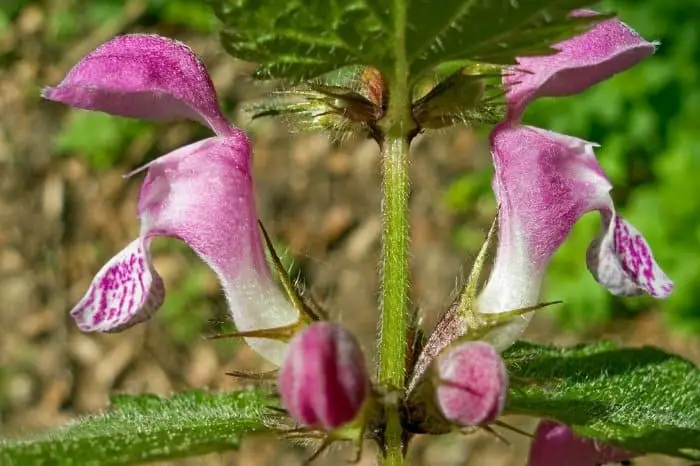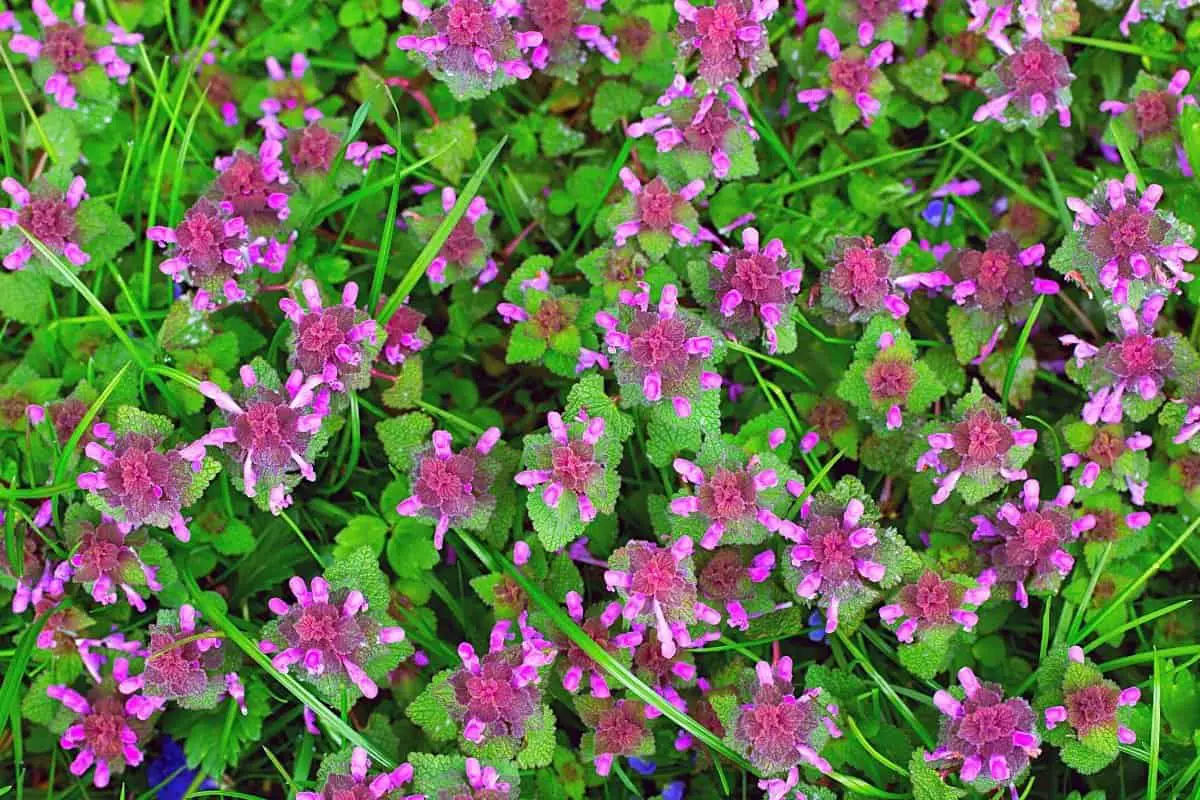Last Updated on February 2, 2022 by
If you have been wondering what are the weeds with purple flowers called, we will introduce you to the most common purple-flowered weeds.
Who doesn’t like flowers blooming in their garden? Flowers are naturally beautiful. They calm our stressed minds and bring a brightness that beats any blues, moreover, if they are purple in color.
In their proper place, flowers are outright lovely. However, when they decide to grow where we have planted other crops, we have a problem. These beautiful flowers become weeds.
Gardeners dislike the time and work it takes to keep weeds away from their gardens. However, some actually enjoy weeding as a part of gardening therapy.
Not all weeds are bad; some like dandelions or chickweed have nutritional value, while others, like the purple weed flower, are pretty to look at their cheerful blooms.
Weeds With Purple Flowers
Now that you know some of the different garden and yard weeds, let’s identify some that have purple flowers. When you get to know what they are, you will choose to either remove them or use them. The common purple weeds are:
Forget Me Not (Myosotis Sylvatica)
This perennial weed can be cultivated in border plantings because they grow fast and are easy to care for. Within a short time, they can grow out of control and take over your garden or even creep into your lawn.
The downside of this plant is that it grows vigorously, getting into gardens where it’s not needed. Many extension officers have labeled it a weed that can be controlled with early detection.
This plant has blue to purple flowers with nicely rounded petals and a yellow center. They are lovely to behold and aggressive growers.

Uses Of This Weed Flower
It is a herb with edible flowers used in decorating cakes and candies. It can also be used in salads, as a garnish for gourmet, and in teas.
Please note some of the Myosotis plants are toxic. Be sure to use it only under expert guidance, especially when considering it for internal use.
Henbit (Lamium Amplexicaule)
Henbit belongs to the mint family and closely resembles the purple dead nettle. Its flowers are pink, purple, or white and have the same tubular formations as purple dead nettle.
Henbit attracts pollinators like bumblebees, honeybees, and hummingbirds. This weed flower thrives in the sun and loamy soil in moist areas. It commonly grows around ponds or water features, and turtles love to eat them.
Uses Of Henbits
Henbit leaves, stems, and flowers are edible. Its leaves are cooked or eaten raw in salads, as they are similar to spinach.

The leaves, flowers, and stems are used medicinally to treat rheumatism, reducing fevers. The leaves add beauty and nutrients to salads, while the flowers add a lovely purple color. The flowers are also useful in garnishing as decoration and making teas.
How To Get Rid Of Henbit
Henbit is known to spread via seed production. You can prevent the seeds from spreading and greatly control the growth of this plant.
Use herbicide to cripple it early before it gets to see production. You can also hand-pull henbit before it produces the seeds. After it has seeds, hand-pulling might distribute the seeds more.
Ground Ivy (Glechoma Hederacea)
Ground ivy is a cousin of the mint family (Lamiaceae). Just like its minty cousins, this ivy grows aggressively, surviving in most weather conditions.
This plant forms a low carpet and spreads vigorously across the garden. If left to grow, it will deprive the plants of all the nutrients.
Ivy Herb Tea Organic Quality – Glechoma Hederacea – 100g
This weed has light purple flowers that bloom in late spring to early summer. The flower is small, with lobe-shaped petals forming ahead of four lobes. Though not likely to be cultivated by gardeners, it is very unfussy and grows everywhere from the floodplains to the mountains.
The best time to get rid of ground ivy is when it goes dormant during summer.
Uses Of Ground Ivy
The blossoms and leaves of ground Ivy are edible and cook like spinach. It has a mild sage and mint-like taste. Ground Ivy is used for brewing ale for homebrewers, make pies and salads. You can also use it to make broth, tea, and stuffing mixes. This plant can serve you with its medicinal benefits, including arthritis and joint pain, bladder infections, hemorrhoids, bladder stones, kidney stones, diarrhea, and diuretic.
Purple Dead Nettle (Lamium Purpureum)
Purple dead weed is an annual weed that has purple flowers. It is aggressive and fast-growing, with annual blooms colored pink, purple, and white flowering from mid-spring into summer. Some gardeners do not like to eradicate this weed for one major reason; it attracts essential pollinators like honeybees and bumblebees.
Its flowers form in groups of 4 petals, forming a tubular shape. They grow downward in a cone shape and might have a purplish color on them.
Uses Of Purple Deadnettle
Purple deadnettle is a nutritious weed with medicinal benefits in its leaves and flowers. Used as a herb or any other leafy green plant. You can dry the leaves and flowers and use them for tea. You can use it in salads, green juice, and smoothies, or soups. It also has some medicinal qualities as an antifungal, anti-inflammatory, antibacterial, diuretic, and poultice for cuts and wounds.
Find out the Best Way to Get Rid of Dandelions Permanently
Conclusion
Now that you know what the weeds with purple flowers are called, you can decide what’s next.
In some cases, gardeners see the value of these weed flowers attracting bees, being edible, and having a medicinal effect. However, in some cases, if the purple flower weeds are a threat to the crops, you may eliminate them.
Generally, it depends on what you are growing. Can you be able to grow it among the purple-flowered weeds or not. Alternatively, can you be able to move the purple weeds to grow elsewhere once you notice them growing among your crops?
Making a wise decision will enable you to get benefits from your crop and your purple flowers. You can therefore choose what you want to keep with knowledge.
FAQs
What kind of weeds have purple flowers?
Weeds can be a nuisance and in some cases an invasive species that needs to be controlled.
Purple flowers are a beautiful, and rare, part of the natural world, but when you see them on your property you may want to know what kind of weed they are. If you live in New Hampshire or Maine you’ve probably seen these flowers growing along roadsides, in ditches, and even along power lines.
There are a lot of different kinds of weeds that have purple flowers, but the most common are probably purple loosestrife (Lythrum salicaria) and black nightshade (Solanum nigrum).
Another common weed in gardens is Tagetes lucida. It's also known as French marigold, or Spanish marigold. It has been used as a dye plant and in medicine. It has purple flowers with yellow centers. It's not toxic to animals, but you should be aware of it because it will compete with other plants.
What are the tall weeds with purple flowers called?
They are wildflowers, and they are called violets (or violet) and purple loosestrife or purple flag Violets.
Is Creeping Charlie the same as wild violet?
Creeping Charlie is a very easy and rewarding garden plant to grow. It is not invasive and doesn't require much maintenance. It is also extremely pretty, with its blue-violet flowers that are surrounded by white bracts. Wild violet (Viola tricolor) is a more common plant in the UK, but it has different leaves than creeping Charlie and is not nearly as pretty.
What are the most beautiful purple flower weeds?
One of the most beautiful purple flower weeds are: Aster littoralis (commonly known as sea aster or starflower) is a flowering plant of the Asteraceae family native to much of North America and Europe. It has daisy-like flowers with yellow centers surrounded by purple rays.
There's also one called "Purple coneflower", which is Aster oblongifolius. It's not in the same genus, but the two are related, as Aster is part of the composite family Compositae.
Are purple flower weeds closely related to grasses?
Purple flower weeds are a species of flowering plants, or angiosperms. They are not closely related to grasses, although they were once thought to be, and the name “purple” is also used for some grasses.
Where are purple flower weeds found?
Purple flower weeds are common to most areas of the world.
They are found in wetland areas, especially near the coast.
Purple flowers or flower heads are found in many different kinds of plants. They are common on some species of wildflowers, but are also found on other types of plants. Purple flower weeds are usually found in places with a lot of moisture and sun, such as prairies and meadows. They grow very well in wet soil, which is why they are often found near rivers and streams.
Do purple flower weeds need a lot of sun?
Yes, they need lots of sun. If they are planted in shady locations, they will be slow to grow. Purple flowers are generally not considered weeds, but it's usually best to remove them if you can. They can compete for nutrients and light with grass.
Caroline is a gardener who loves to get down to the nitty–gritty of gardening. She proudly proclaims herself as a ‘dirt worshipper‘ and can often be found deep in the garden, covered in soil and singing to her plants. As a self–proclaimed ‘plant whisperer‘, Caroline believes that plants need love and attention just like any other living thing, and she loves to give them both. When she‘s not tending to her garden, you can often find her researching the latest gardening trends, or teaching others how to make their gardens thrive



